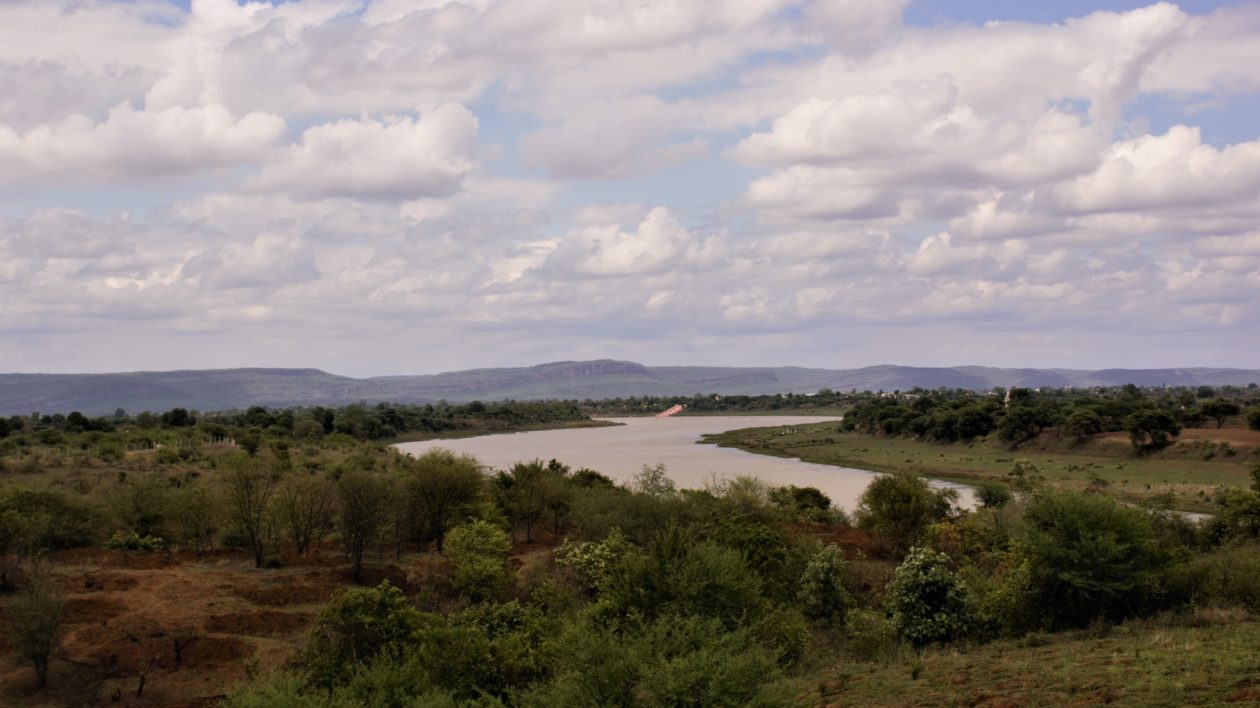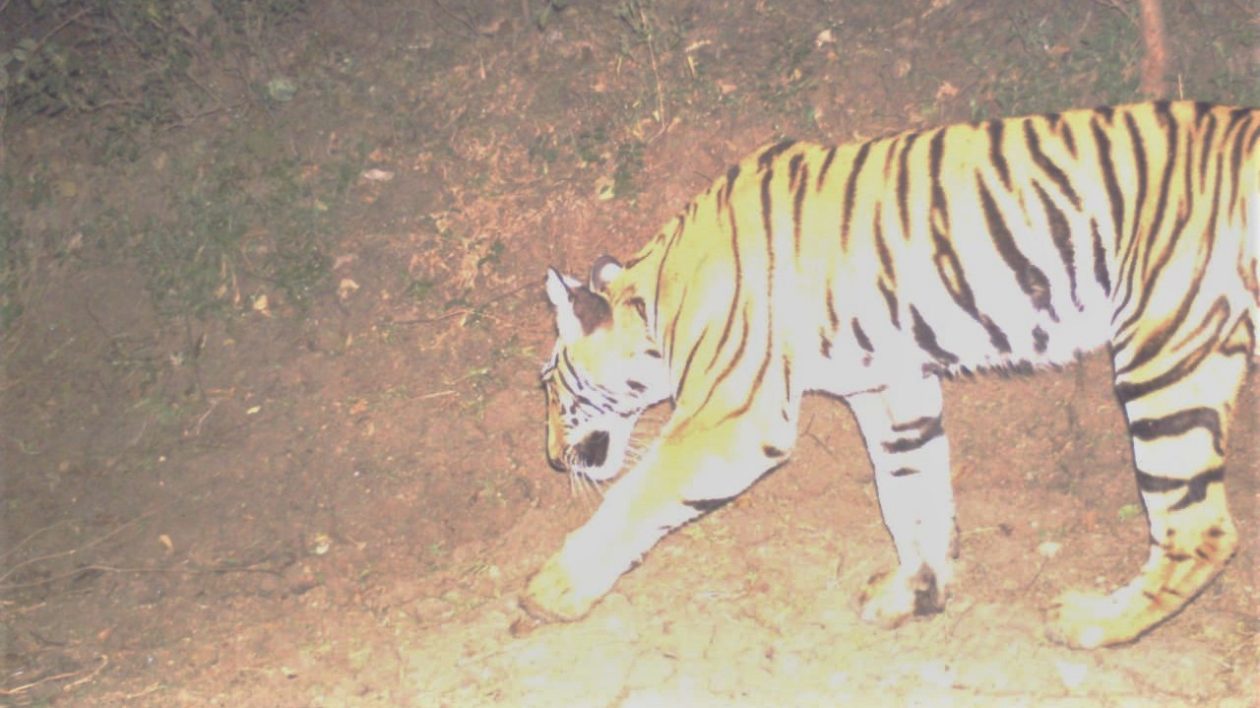Recently an endangered Bengal tiger was seen by villagers at Surajkund, Madhya Pradesh in an area near one of the Nature Conservancy’s riparian habitat restoration site at Dhansi. The nearby Satpura Tiger Task Force set up camera traps in an attempt to verify the sightings.
To everyone’s delight, on March 4th a tiger unknowingly took a photo of itself on a night-time stroll.
The presence of a tiger in the area provides encouragement that our River Narmada Project is on track to provide much-needed extra habitat for tigers and the herbivores they prey upon along parts of India’s fifth-largest river.
Restoring River Basins
A third of the Narmada river basin is forested, and it’s home to 17 percent of the world’s wild tigers along with 25 million people. Due to anthropogenic and climatic pressure, the entire ecosystem of this iconic river basin is under threat, especially the riparian habitat in between rivers and surrounding lands.
To arrest further loss and revegetate the river’s riparian areas, TNC India is supporting the Madhya Pradesh government in providing a science-based solution to improve the impact of riparian habitat conservation work.

Since 2017, we have undertaken scientific studies, build the capacity of community members, developed local relationships, and implemented restoration work in two riparian model sites: Dhansi and Ajera, in the Hoshangabad district.
The ecological landscape between the Narmada River and the Satpura Tiger Reserve is fragmented due to extensive agricultural practices, deforestation and other development work.
Conserving and restoring small linkage zones, like riparian habitat, is an important mitigation measure to reduce the human-caused landscape change that negatively impacts biodiversity. This improved connectivity acts like stepping stones, helping to preserve natural biological processes such as long-range movements of many wide-ranging animals, including the tiger.
The Satpura Tiger Reserve has 50 tigers, and they move freely through degraded forest patches and agricultural land for prey and other activities. Our improved thin riverine riparian forest strips act as a functional corridor for many other species, including tigers, other carnivores, grassland birds, raptors, butterflies, spotted deer, blackbuck, reptiles and many others.

Both sites are situated on the northern side of the central Narmada Vaalley and the Satpura Biosphere Reserve. We have documented 70 birds and 30 butterflies from these two sites along with 38 tree, 11 shrub, 84 herbs 9 climber and 15 grass species.
These two sites are also significant in terms of archaeological, paleontological and cultural points of view. Scientists discovered a Middle Pleistocene hominid calvaria here. Known as ‘Narmada Man,’ or Homo erectus narmadensis, it is one of the oldest fossils of human ancestry.
Gradual improvement in the riparian sites means they are now acting as both structural and functional corridors for flora and fauna species, motivating local community members who are coming forward to actively protect and preserve their mystical Narmada riparian land.

A Sad History of Global Tiger Decline
Being amongst the most beautiful and powerful of all animals on Earth hasn’t spared the tiger from a sad and tragic decline. Tigers were originally found across much of Asia, from Turkey in the west to Russia and North Korea in the east, southwards from the foothills of the Himalayas in Nepal, Bhutan and India to equatorial Indonesia.
They are a highly adaptable species, inhabiting marshlands, woodlands and forests that can be deep in snow in winter, like Siberia, or hot and wet all year round, like Sumatra.
Due to a range of human-induced pressures – most significantly poaching for the illicit eastern medicine trade and the loss of habitat and/or prey species within remaining habitat – tigers have suffered a catastrophic decline.
The Bali, Caspian and Javan tigers species are all extinct, exterminated by the 1950s (Bali) and the late 1970s (Caspian and Javan). Today the total global wild tiger population is somewhere between 4,500 and 5,500 tigers, which is less than the number of animals in captivity.
But there is hope in India. Our Bengal tigers are faring better than other surviving tiger types, ad their population actually increased to an estimated 3,000 tigers in 2019, or around 60 percent of all wild tigers.





I will be thrilled the say tigers are no longer hunted, and are not endangered. The Nature Conservancy is on the right track, as always great pictures. Great work! Thank you!
So very glad there is some reason for optimism somewhere with regards to tiger survival. They are magnificent and adaptable creatures if given half a chance. It is for animals like this that the decline in world human population may bode well. Thankful also for all these 24-hr cameras that can help monitor wildlife. Hoping to put one up in my backyard just to take a look around!
Freda and Denise,
I wouldn’t be able to hazard a guess, but it sounds like unusual opossum behavior. I should note that wild animals live far more complex lives than we often even imagine (and science is revealing this). The two may stick together for any number of mutually beneficial reasons.
Thank you for your comments and questions. I am glad you learn from and enjoy my stories. It means a lot.
Best,
Matt